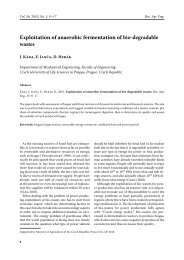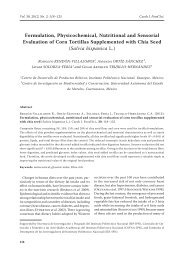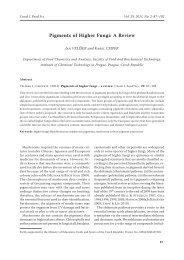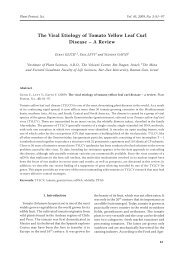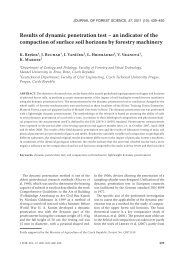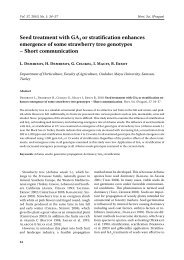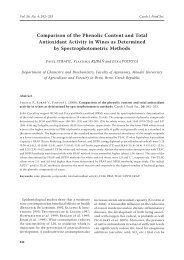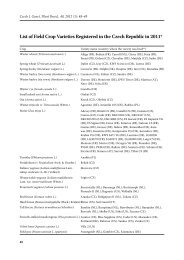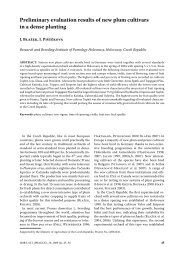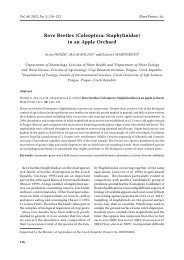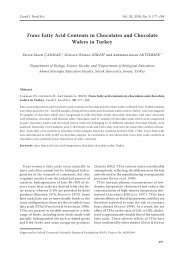Efficacy loss of strobilurins used in protection against apple scab in ...
Efficacy loss of strobilurins used in protection against apple scab in ...
Efficacy loss of strobilurins used in protection against apple scab in ...
Create successful ePaper yourself
Turn your PDF publications into a flip-book with our unique Google optimized e-Paper software.
Hort. Sci. (Prague) Vol. 40, 2013, No. 2: 45–51<br />
<strong>Efficacy</strong> <strong>loss</strong> <strong>of</strong> <strong>strobilur<strong>in</strong>s</strong> <strong>used</strong> <strong>in</strong> <strong>protection</strong> aga<strong>in</strong>st<br />
<strong>apple</strong> <strong>scab</strong> <strong>in</strong> Czech orchards<br />
P. Sedlák 1 , R. Vávra 2 , P. Vejl 1 , S. Boček 3 , J. Kloutvorová 2<br />
1 Department <strong>of</strong> Breed<strong>in</strong>g and Genetics, Faculty <strong>of</strong> Agrobiology, Food and Natural Resources,<br />
Czech University <strong>of</strong> Life Sciences Prague, Prague, Czech Republic<br />
2 Research and Breed<strong>in</strong>g Institute <strong>of</strong> Pomology <strong>in</strong> Holovousy Ltd., Holovousy, Czech Republic<br />
3 Department <strong>of</strong> Breed<strong>in</strong>g and Propagation <strong>of</strong> Horticultural Plants, Faculty <strong>of</strong> Horticulture,<br />
Mendel University <strong>in</strong> Brno, Brno, Czech Republic<br />
Abstract<br />
Sedlák P., Vávra R., Vejl P., Boček S., Kloutvorová J., 2013. <strong>Efficacy</strong> <strong>loss</strong> <strong>of</strong> <strong>strobilur<strong>in</strong>s</strong> <strong>used</strong> <strong>in</strong> <strong>protection</strong><br />
aga<strong>in</strong>st <strong>apple</strong> <strong>scab</strong> <strong>in</strong> Czech orchards. Hort. Sci. (Prague), 40: 45–51.<br />
The <strong>apple</strong> <strong>scab</strong> ca<strong>used</strong> by Venturia <strong>in</strong>aequalis is important <strong>apple</strong> disease <strong>in</strong> temperate zone. Economical <strong>loss</strong>es ca<strong>used</strong><br />
by the pathogen are effectively reduced by <strong>in</strong>tensive chemical <strong>protection</strong> and breed<strong>in</strong>g. Occurrences <strong>of</strong> pathogen resistance<br />
to strobilur<strong>in</strong> fungicides were noted <strong>in</strong> some Czech orchards <strong>in</strong> the past. In 2007–2011, collection <strong>of</strong> 136 isolates<br />
V. <strong>in</strong>aequalis was tested with the aim to detect presence <strong>of</strong> s<strong>in</strong>gle-po<strong>in</strong>t mutations <strong>of</strong> cytochrom b (cytb) gene caus<strong>in</strong>g<br />
efficacy <strong>loss</strong> <strong>of</strong> <strong>strobilur<strong>in</strong>s</strong>. Consequently occurrence <strong>of</strong> beta-tubul<strong>in</strong> (beta-tub) gene mutation caus<strong>in</strong>g resistance to<br />
benomyl was studied with the aim to obta<strong>in</strong> comparative data about frequency <strong>of</strong> mutation <strong>in</strong> non-selective environment.<br />
Therefore simple and highly repeatable PCR based mutation detect<strong>in</strong>g methods were optimised. Analysis brought<br />
knowledge about high similarity <strong>of</strong> cytb and beta-tub genes mutations occurrence. Whilst the frequency <strong>of</strong> the G143A<br />
substitution <strong>in</strong> cytb gene was 65% the E198A substitution <strong>of</strong> beta-tub gene occurred <strong>in</strong> 54% with<strong>in</strong> pathogen population.<br />
This high frequency <strong>of</strong> resistant population necessitates revision <strong>of</strong> the way <strong>of</strong> <strong>strobilur<strong>in</strong>s</strong> use <strong>in</strong> <strong>apple</strong> <strong>scab</strong> management.<br />
Keywords: Venturia <strong>in</strong>aequalis; resistance to fungicides; cytochrom b gene; PCR based detection <strong>of</strong> mutations<br />
Apple <strong>scab</strong> is the major disease <strong>in</strong> <strong>apple</strong> tree orchards<br />
worldwide ca<strong>used</strong> by ascomycete Venturia<br />
<strong>in</strong>aequalis (Cooke) W<strong>in</strong>ter. S<strong>in</strong>ce the production <strong>of</strong><br />
<strong>apple</strong>s currently depends on chemical <strong>protection</strong>,<br />
breed<strong>in</strong>g <strong>of</strong> new cultivars resistant to V. <strong>in</strong>aequalis<br />
is develop<strong>in</strong>g for long time as possible solution<br />
reduc<strong>in</strong>g the usage <strong>of</strong> chemicals <strong>in</strong> <strong>apple</strong> <strong>protection</strong><br />
(Williams, Kuc 1969). Resistance <strong>of</strong> cultivars<br />
based on Rvi6 (Vf) gene was overcome by pathogen<br />
races 6 and 7 <strong>in</strong> orchards across Europe (Parisi et<br />
al. 1993; Roberts, Crute 1994; Bénaouf, Parisi<br />
2000; Bus et al. 2005). The first break <strong>of</strong> Rvi6 (Vf)<br />
determ<strong>in</strong>ed resistance <strong>in</strong> the Czech Republic was<br />
recorded <strong>in</strong> four separate locations <strong>in</strong> 2006. Also<br />
chemical management <strong>of</strong> <strong>scab</strong> is exposed to enormous<br />
pathogen adaptation ability. Occurrence <strong>of</strong><br />
pathogen resistance to fungicide is an important<br />
issue <strong>in</strong> modern agriculture. Strobilur<strong>in</strong>s and benzimidazoles<br />
are examples <strong>of</strong> s<strong>in</strong>gle-site <strong>in</strong>hibitors<br />
for <strong>apple</strong> <strong>scab</strong> <strong>protection</strong>, which were released to<br />
the market <strong>in</strong> the late 1970’s and <strong>in</strong> the mid 1990’s.<br />
In 2011 the total consumption <strong>of</strong> <strong>strobilur<strong>in</strong>s</strong> was<br />
Supported by the M<strong>in</strong>istry <strong>of</strong> Agriculture <strong>of</strong> the Czech Republic, Project No. QH71172.<br />
45
Vol. 40, 2013, No. 2: 45–51<br />
Hort. Sci. (Prague)<br />
430 kg what presents 0.3% from <strong>of</strong> 148.8 t <strong>of</strong> total<br />
consumption <strong>of</strong> fungicides <strong>used</strong> <strong>in</strong> fruit plants <strong>protection</strong><br />
<strong>in</strong> the Czech Republic. In five years period<br />
from 2007–2011, the total <strong>strobilur<strong>in</strong>s</strong> consumption<br />
was relatively stabilised. Strobilur<strong>in</strong>s belong<br />
to important class <strong>of</strong> fungicides <strong>in</strong> plant <strong>protection</strong><br />
aga<strong>in</strong>st many phytopathogenic fungi. They have<br />
been successfully <strong>used</strong> <strong>in</strong> Europe to control the <strong>apple</strong><br />
<strong>scab</strong> s<strong>in</strong>ce 1998. They are known as Qu<strong>in</strong>one<br />
outside Inhibitors (QoI) <strong>in</strong>fluenc<strong>in</strong>g respiration<br />
pathway controlled by cytb gene (Bartlett et al.<br />
2002). Mode <strong>of</strong> action <strong>of</strong> benzimidazoles affects<br />
mitotic processes and cytoskeletal development<br />
(Davidse 1986). Because the mode <strong>of</strong> action <strong>of</strong><br />
both groups is highly specific, the risk <strong>of</strong> pathogen<br />
resistance is generally very high; and really<br />
resistance <strong>of</strong> V. <strong>in</strong>aequalis to both <strong>of</strong> groups was<br />
developed with<strong>in</strong> two years <strong>of</strong> <strong>in</strong>tensive use. While<br />
benzimidazoles are not registered for <strong>protection</strong><br />
aga<strong>in</strong>st the <strong>scab</strong> <strong>in</strong> the Czech Republic, presently<br />
<strong>strobilur<strong>in</strong>s</strong> are registered for wide use <strong>in</strong> many<br />
crops. In contrast, fungicides with more than one<br />
target site <strong>in</strong> the fungal cell have been <strong>used</strong> for<br />
more than 30 years before the resistant isolates<br />
have been found (Deis<strong>in</strong>g et al. 2008). Key cytb<br />
gene mutation G143A caus<strong>in</strong>g very high resistance<br />
<strong>of</strong> V. <strong>in</strong>aequalis to <strong>strobilur<strong>in</strong>s</strong> described Zheng et<br />
al. (2000). Mutant allele E198A <strong>of</strong> the beta-tubul<strong>in</strong><br />
(beta-tub) gene l<strong>in</strong>ked to high level <strong>of</strong> resistance<br />
to benomyl identified Koenraadt et al. (1992).<br />
The speed <strong>of</strong> mutants’ propagation depends on the<br />
pathogen biology as well as the number <strong>of</strong> fungicide<br />
applications per season (Sierotski et al. 2000;<br />
Barr et al. 2005; Lesemann et al. 2006; Chen et al.<br />
2007). Last research objectives lead to develop<strong>in</strong>g<br />
<strong>of</strong> different detection techniques for monitor<strong>in</strong>g <strong>of</strong><br />
causal mutations (Michalecka et al. 2011).<br />
The ma<strong>in</strong> objective <strong>of</strong> this study was to evaluate<br />
frequency <strong>of</strong> G143A and E198A mutations, to br<strong>in</strong>g<br />
the <strong>in</strong>formation about dispersion <strong>of</strong> mutants <strong>in</strong> orchards<br />
<strong>in</strong> the Czech Republic and <strong>in</strong>form about<br />
potential risk <strong>of</strong> <strong>strobilur<strong>in</strong>s</strong> use <strong>in</strong> <strong>apple</strong> grow<strong>in</strong>g<br />
systems.<br />
Table 1. Parameters <strong>of</strong> <strong>used</strong> primers<br />
MATERIAL AND METHODS<br />
Obta<strong>in</strong><strong>in</strong>g and cultivation <strong>of</strong> V. <strong>in</strong>aequalis isolates.<br />
In total 136 cultures <strong>of</strong> V. <strong>in</strong>aequalis from<br />
26 localities <strong>in</strong> the Czech Republic were collected and<br />
analysed <strong>in</strong> years 2007–2011. Isolates were collected<br />
<strong>in</strong> both <strong>scab</strong> resistant cultivars affected by pathogen<br />
<strong>scab</strong> races and chemically treated orchards <strong>of</strong> <strong>scab</strong><br />
susceptible cultivars where the <strong>strobilur<strong>in</strong>s</strong> efficacy<br />
<strong>loss</strong> was repeatedly reported. Also isolates from never<br />
treated trees were obta<strong>in</strong>ed. Conidia from sporeform<strong>in</strong>g<br />
lesions <strong>of</strong> <strong>in</strong>fected leaves were transferred to<br />
Petri dish with 2% Water Agar medium (Fluka, Sigma<br />
Aldrich, Seelze, Germany) and spread on the surface<br />
by dry sterile glass stick. After 48 h <strong>in</strong>cubation <strong>in</strong><br />
22 ± 2°C germ<strong>in</strong>ated conidia were found under microscope<br />
and transferred to 4% Chloramphenicol Yeast<br />
Glucose Agar (HIMEDIA, Mumbai, India) to avoid<br />
undesirable contam<strong>in</strong>ation. Cultures were ma<strong>in</strong>ta<strong>in</strong>ed<br />
alternately on 3.9% PDA (Potato Dextrose Agar, HI-<br />
MEDIA) and 4% Malt Extract Agar (HIMEDIA).<br />
Test <strong>of</strong> conidia germ<strong>in</strong>ation and mycelial<br />
growth <strong>in</strong> kresoxim-methyl. Conidia germ<strong>in</strong>ation<br />
was tested <strong>in</strong> 80 ml drops <strong>of</strong> 0.02% (w/v) solution<br />
<strong>of</strong> kresoxim-methyl (KM) fungicide Discus (BASF,<br />
Ludwigshafen, Germany). Rate <strong>of</strong> spores’ germ<strong>in</strong>ation<br />
<strong>in</strong> drops <strong>of</strong> tap water was <strong>used</strong> as control. Conidial<br />
suspensions were <strong>in</strong>cubated at the dip slides at<br />
22 ± 2°C for 48 h <strong>in</strong> the daylight. After <strong>in</strong>cubation<br />
500 <strong>of</strong> conidia were counted per sample. Each conidium<br />
produc<strong>in</strong>g the germ 1.5 times longer than the<br />
length <strong>of</strong> a spore was evaluated as germ<strong>in</strong>at<strong>in</strong>g. For<br />
each sample the Relative Conidia Germ<strong>in</strong>ation (RCG)<br />
was calculated. RCG = % <strong>of</strong> germ<strong>in</strong>at<strong>in</strong>g conidia <strong>in</strong><br />
KM × 100/% <strong>of</strong> germ<strong>in</strong>at<strong>in</strong>g conidia <strong>in</strong> tap water.<br />
In mycelial growth assay 20 monosporic mycelial<br />
plugs (2–3 mm 2 ) <strong>of</strong> each isolate were transferred<br />
from seven days old PDA culture to PDA plates<br />
supplemented with 0.2 g/l <strong>of</strong> the Discus and simultaneously<br />
on control plates without fungicide<br />
supplement. Fungicide was added after PDA sterilization<br />
<strong>in</strong>to fluid medium at 40°C. Plates were <strong>in</strong>cubated<br />
for 21 days at 22 ± 2°C <strong>in</strong> the daylight. The<br />
Gene Primer Sequence 5'–3' T m<br />
(°C) Position <strong>in</strong> gene Length (bp) F<strong>in</strong>al analysis<br />
cytb<br />
VB4F<br />
VB4R<br />
tgcaagataaatctgagttgacg<br />
tgttgttaggctcttcaatgaataat<br />
58 5390–5547 exon 4 158 SSCP<br />
beta-tub<br />
T6IIF<br />
T6IIR<br />
ctccaagattcgcgagga<br />
tggataagattgttagcaggtgtg<br />
58 1218–1767 exon 6 550 BstUI<br />
SSCP – ssDNA conformation polymorphism detect<strong>in</strong>g method<br />
46
Hort. Sci. (Prague) Vol. 40, 2013, No. 2: 45–51<br />
Relative Mycelial Growth (RMG) was calculated.<br />
RMG = % <strong>of</strong> mycelial growth <strong>in</strong> KM × 100/% <strong>of</strong> mycelial<br />
growth on plates without KM.<br />
DNA extraction and amplification <strong>of</strong> target<br />
genes’ regions. DNA was extracted from fungal mycelium<br />
by GenElute Plant M<strong>in</strong>i Kit (Sigma Aldrich,<br />
Seelze, Germany). Up to 100 mg <strong>of</strong> mycelium was<br />
homogenised <strong>in</strong> liquid nitrogene (LN) <strong>in</strong> 2 ml polypropylene<br />
tube by glass stick. The LN was added directly<br />
<strong>in</strong>to tube for optimal disruptions <strong>of</strong> mycelium.<br />
The homogenate was extracted us<strong>in</strong>g standard plant<br />
m<strong>in</strong>iprep protocol with two-times prolonged step <strong>of</strong><br />
the lysis. DNA was eluted <strong>in</strong>to two 75 ml portions<br />
<strong>of</strong> TE buffer. Quality <strong>of</strong> DNA sample was evaluated<br />
by NanoPhotometer (Implen, München, Germany).<br />
Primer pairs flank<strong>in</strong>g key parts <strong>of</strong> target genes<br />
were designed by means <strong>of</strong> NCBI Primer-BLAST<br />
(Ye et al. 2012) us<strong>in</strong>g sequences <strong>of</strong> cytb gene (NCBI<br />
entry AF004559 by Zheng et al. 1997) and betatub<br />
gene (NCBI entry M97951 by Koenraadt et<br />
al. 1992). Information about primers are summarised<br />
<strong>in</strong> Table 1. Polymerase cha<strong>in</strong> reaction (PCR)<br />
mixture (25 ml) conta<strong>in</strong>ed 40 ng <strong>of</strong> DNA, 1× Taq +<br />
KCl PCR reaction buffer (Fermentas, Vilnius, Lithuania),<br />
MgCl 2<br />
(2.5 nmol/ml), equimolar mixture <strong>of</strong><br />
dNTP (0.25 nmol/ml), primer pair (0.3 nmol/ml)<br />
and 0.5 unit <strong>of</strong> Taq DNA polymerase (Fermentas).<br />
Amplification conditions were optimised as follows:<br />
1× 95°C 3 m<strong>in</strong> followed by 35 cycles consisted from<br />
denaturation (95°C, 30 s), anneal<strong>in</strong>g (58°C, 30 s) and<br />
extension (72°C, 60 s). Amplification was f<strong>in</strong>ished by<br />
f<strong>in</strong>al extension (72°C, 5 m<strong>in</strong>).<br />
Detection <strong>of</strong> cytb-G143A and beta-tub E198A<br />
mutations. The method detect<strong>in</strong>g ssDNA conformation<br />
polymorphism (SSCP) performed <strong>in</strong> DCodeTM<br />
(Bio-Rad, Hercules, USA) was <strong>used</strong> for detection<br />
G143A. Conditions for SSCP analysis were as follows.<br />
The 16 × 16 cm gel consisted <strong>of</strong> 8% acrylamidebisacrylamide<br />
mixture (37.5:1), 0.5× TBE buffer and<br />
10% <strong>of</strong> glycer<strong>in</strong>e. 10 ml <strong>of</strong> PCR products were mixed<br />
with 10 ml SSCP Load<strong>in</strong>g Dye (Bio-Rad), denaturised<br />
for 10 m<strong>in</strong> at 94°C and immediately moved on<br />
the ice. After 20 m<strong>in</strong> <strong>of</strong> cool<strong>in</strong>g the samples were<br />
loaded on the gels and separated for 3 hours. Power<br />
supply was set on 30 W. Initial temperature <strong>of</strong> separation<br />
system was 5°C and after start <strong>of</strong> separation the<br />
temperature was stabilised by ice bath at 10°C. After<br />
the separation, gels were sta<strong>in</strong>ed by ethidiumbromide<br />
for 15 m<strong>in</strong> and then visualised and documented by<br />
GelDocXR (Bio-Rad). Sta<strong>in</strong><strong>in</strong>g bath consisted <strong>of</strong> 0.5 l<br />
<strong>of</strong> electrophoretic buffer supplemented by 0.8 mg <strong>of</strong><br />
ethidiumbromide.<br />
T6II amplicons were analysed by BstUI restrictase<br />
(Fermentas) with respect to manufacturer’s recommendation.<br />
Polymorphisms were detected by electrophoresis<br />
<strong>in</strong> 2% agarose gel sta<strong>in</strong>ed by ethidiumbromide<br />
(0.5 mg/ml).<br />
RESULTS AND DISCUSSION<br />
Spores germ<strong>in</strong>ation and mycelial growth<br />
under kresoxim-methyl<br />
Set <strong>of</strong> 78 isolates was evaluated by conidia germ<strong>in</strong>ation<br />
test. Mycelial growth was evaluated for<br />
54 isolates. Results showed high rate <strong>of</strong> KM resistance<br />
(Table 2) <strong>in</strong> evaluated isolates. The control isolate<br />
Lázně Bělohrad obta<strong>in</strong>ed from the solitary tree<br />
never treated by fungicides demonstrated RCG = 0<br />
whilst isolates from orchards periodically treated<br />
by <strong>strobilur<strong>in</strong>s</strong> were highly resistant (RCG varied<br />
from 30 to 96%). Already 15% RCG demonstrates<br />
high risk for economically significant disease development.<br />
Similar situation was observed <strong>in</strong> tests <strong>of</strong><br />
relative mycelial growth (RMG). In isolates Choustníkovo<br />
Hradiště, Kamenice (cv. Golden Delicious)<br />
and Břasy RMG equal to 100% was observed. The<br />
test is well <strong>in</strong>formative <strong>in</strong> actual status <strong>of</strong> resistance<br />
<strong>in</strong> orchard and can be good tool to verify <strong>of</strong> resistance<br />
<strong>in</strong> cases when the chemical <strong>protection</strong> failed.<br />
But there was also repeatedly observed low value <strong>of</strong><br />
RCG <strong>of</strong> isolate Rohozec (cv. Šampion) <strong>in</strong> relation to<br />
presence <strong>of</strong> G143A. This discrepancy can be partially<br />
expla<strong>in</strong>ed by f<strong>in</strong>d<strong>in</strong>g <strong>of</strong> Zheng et al. (2000). They<br />
studied mutation ratio <strong>of</strong> the cytb gene <strong>in</strong> laboratory<br />
conditions and results <strong>in</strong>dicated very low value <strong>of</strong><br />
this parameter (about 4.4 × 10 –8 ). If the mutation ratio<br />
<strong>in</strong> natural conditions is similar, molecular analysis<br />
can detect hidden mutation <strong>in</strong> isolate and very<br />
low RCG is then observed due to low abundance<br />
<strong>of</strong> mutated spores <strong>in</strong> the sample. It is possible believe<br />
that the test <strong>of</strong> conidia germ<strong>in</strong>ation is not fully<br />
sufficient to monitor<strong>in</strong>g <strong>of</strong> resistant populations <strong>in</strong><br />
orchards and it should be supported by direct molecular<br />
screen<strong>in</strong>g <strong>of</strong> population. This presumption<br />
corresponds to results <strong>of</strong> Fonta<strong>in</strong>e et al. (2008).<br />
Molecular detection <strong>of</strong> cytb<br />
and beta-tub mutations<br />
Primers VB4 amplified fragment 158 bp <strong>in</strong>clud<strong>in</strong>g<br />
the exon 4 <strong>of</strong> cytb <strong>in</strong> accordance with expected<br />
47
Vol. 40, 2013, No. 2: 45–51<br />
Hort. Sci. (Prague)<br />
Table 2. Characterization <strong>of</strong> Venturia <strong>in</strong>aequalis isolates<br />
Locality Cultivar G143A freq. E198A freq. RCG (%) RMG (%)<br />
Bílé Podolí Golden Delicious 1.0 1.0 59 n<br />
Brno Golden Delicious 0.0 0.0 31 93<br />
Břasy Unk. 1.0 1.0 30 100<br />
Dobrá Voda Jonagold 1.0 0.0 62 96<br />
Dolany Golden Delicious 1.0 1.0 37 85<br />
Holovousy ”Včelín“ Idared 1.0 0.86 88 100<br />
Holovousy ”Školka“ TSR33T239 1.0 1.0 n n<br />
Holovousy ”Kamenec“ Gloster 1.0 1.0 96 94<br />
Choustníkovo Hradiště Jonagold 1.0 0.5 91 100<br />
Kamenice Golden Delicious 1.0 0.5 67 100<br />
Kamenice Šampion 1.0 0.0 72 76<br />
Kladno ”Štěpánská“ Unk. 0.0 0.5 n n<br />
Kladno ”Sítná“ Unk. 0.0 0.0 n n<br />
Kopidlno Otava 0.0 0.0 n n<br />
Lázně Bělohrad Unk. 0.0 0.5 0 0<br />
Lomnice Rub<strong>in</strong>ola 0.0 0.0 n n<br />
Lomnice Šampion 0.0 0.0 n n<br />
Lomnice Selena 0.0 0.0 n n<br />
Lysice ”Agrokonzor“ Golden Delicious 1.0 1.0 n n<br />
Lysice Topaz 0.0 0.0 n n<br />
Lysice Vanda 0.0 0.0 n n<br />
Lysice Jonagold 1.0 1.0 40 100<br />
Lysice Topaz 1.0 0.0 n n<br />
Petrovičky Golden Delicious 1.0 0.66 41 n<br />
Praha Ruzyně Rubín 1.0 1.0 52 84<br />
Radňov Panenské 0.0 0.0 n n<br />
Rohozec Šampion 1.0 0.5 3 n<br />
Rohozec Idared 1.0 1.0 n n<br />
Rohozec OR45T132 0.0 0.0 n n<br />
Rohozec Prima 0.0 0.0 n n<br />
Rohozec ”Brťov-Jeneč“ Goldstar 0.0 0.5 n n<br />
Rohozec ”Brťov-Jeneč“ Rub<strong>in</strong>ola 0.5 0.0 n n<br />
Starý Lískovec Unk. 1.0 1.0 31 n<br />
Těšetice Golden Delicious 1.0 0.58 34 n<br />
Tišnov Selena 1.0 0.0 n n<br />
Tišnov Topaz 1.0 0.0 n n<br />
Tuchoraz Golden Delicious 1.0 1.0 95 97<br />
Velké Bílovice Golden Delicious 1.0 1.0 59 92<br />
Velké Němčice Idared 1.0 1.0 n n<br />
Velký Třebešov Golden Delicious 1.0 1.0 n n<br />
Veselý Žďár Rubín 0.0 0.66 n n<br />
Žernov Topaz 1.0 1.0 n n<br />
Unk. – unknown genotype; n – not evaluated; RCG – relative conidia germ<strong>in</strong>ation; RMG – relative mycelial growth<br />
48
Hort. Sci. (Prague) Vol. 40, 2013, No. 2: 45–51<br />
Fig. 1. Electrophoreograms<br />
(a) lanes from the left: 1–3 – mutation G143A; 4–5 wild type allele cytb., (b) lanes from the left: 1–2 – mutation E198A;<br />
3–6 wild type allele beta-tub<br />
length. Amplicons from KM-resistant and KMsensitive<br />
V. <strong>in</strong>aequalis stra<strong>in</strong>s were sequenced<br />
with the aim to verify the amplicon identity and<br />
causality <strong>of</strong> mutation to resistance <strong>of</strong> our isolates.<br />
The G/C substitution was found <strong>in</strong> the nucleotide<br />
77 <strong>of</strong> the amplicon typical for KM-highly resistant<br />
stra<strong>in</strong>s. Results corresponded to Zheng and<br />
Köller (1997) because presence <strong>of</strong> mutation is<br />
<strong>in</strong> the typical po<strong>in</strong>t (G143A). Others mutations<br />
described <strong>in</strong> cited work and caus<strong>in</strong>g partial resistance<br />
were not detected <strong>in</strong> our samples. It can be<br />
expla<strong>in</strong>ed by rare occurrence <strong>of</strong> these mutations or<br />
by their low potential to express the resistance and<br />
also due to low selection pressure <strong>of</strong> fungicide. Optimised<br />
SSCP analysis detected differences <strong>in</strong> relative<br />
electrophoretic mobility (REM) <strong>of</strong> <strong>in</strong>dividual<br />
ssDNA molecules <strong>in</strong> patterns <strong>of</strong> KM-resistant and<br />
KM-sensitive stra<strong>in</strong>s (Fig. 1). Although this method<br />
was developed about 20 years ago it is <strong>used</strong> <strong>in</strong> many<br />
applications as reported Hayashi (1992) or Ortí<br />
et al. (1997). The ma<strong>in</strong> advantage <strong>of</strong> the method<br />
is simplicity and cheapness (it does not need expensive<br />
laboratory equipment) so it is suited also<br />
for small laboratories. Credibility <strong>of</strong> the method<br />
was tested <strong>in</strong> all samples <strong>in</strong> absolute concordance<br />
<strong>of</strong> SSCP dimorphism and nucleotide sequence <strong>of</strong><br />
amplicon. Association <strong>of</strong> G143A distribution and<br />
results <strong>of</strong> both fungicide tests were evaluated. The<br />
critical value <strong>of</strong> RCG was set at 15%. Results <strong>of</strong><br />
germ<strong>in</strong>ation test and presence <strong>of</strong> G143A highly associated<br />
(association coefficient Q = 0.9562). The<br />
correlation coefficient (r = 0.5259) was found as<br />
highly significant at significance value α = 0.01. Association<br />
<strong>of</strong> molecular results and mycelial growth<br />
<strong>in</strong> KM positive plates was similar (Q = 1.0 and<br />
r = 0.8854). Isolate Brno didn’t show presence <strong>of</strong><br />
the G143A and simultaneously it was evaluated as<br />
resistant <strong>in</strong> the both <strong>of</strong> fungicide tests. Zheng et al.<br />
(2000) observed this <strong>in</strong> several cases and identified<br />
an alternative pathway to mitochondrial respiratory<br />
cha<strong>in</strong>. This is probably the reason <strong>of</strong> our f<strong>in</strong>d<strong>in</strong>g<br />
because <strong>of</strong> relatively low RCG <strong>of</strong> the isolate when<br />
conidia can be more susceptible.<br />
Detection <strong>of</strong> E198A mutation <strong>of</strong> beta-tub gene<br />
brought expected results. Primer set T6II amplified<br />
DNA fragment <strong>in</strong> length 550 bp <strong>in</strong> all evaluated<br />
genotypes and BstUI restrictase assay detected two<br />
alleles <strong>of</strong> this marker <strong>in</strong> isolates collection. Cleavable<br />
marker provided two restriction fragments<br />
<strong>in</strong> length 412 bp and 138 bp and it should be associated<br />
to benomyl resistance (Koenraadt et al.<br />
1992). In our work resistance to benomyl was not<br />
evaluated. Descriptive results <strong>of</strong> molecular analyses<br />
Table 2, Figs 1 and 2 certify.<br />
No<br />
mutation<br />
31%<br />
G143A<br />
15%<br />
E198A<br />
4%<br />
Fig. 2. Distribution <strong>of</strong> mutation with<strong>in</strong> isolates<br />
G143A +<br />
E198A<br />
50%<br />
Komplexní rezistence 68<br />
Absence mutací 42<br />
Mutace cytb 20<br />
Mutace beta-tub 5<br />
49
Vol. 40, 2013, No. 2: 45–51<br />
Hort. Sci. (Prague)<br />
Fig. 3. Distribution <strong>of</strong> G143A and E198A mutants with<strong>in</strong> 2007–2011<br />
Occurrence <strong>of</strong> mutations<br />
<strong>in</strong> the Czech Republic<br />
In 31% <strong>of</strong> isolates were not detected any mutations<br />
and conversely 50% isolates accumulated both mutations.<br />
It is important that G143A substitution was<br />
noted <strong>in</strong> 65% isolates while the E198A was detected<br />
<strong>in</strong> 54% <strong>of</strong> isolates (Fig. 2). Map (Fig. 3) <strong>in</strong>forms about<br />
distribution <strong>of</strong> resistant stra<strong>in</strong>s <strong>in</strong> the Czech Republic.<br />
It is evident, that mutants are spread out <strong>in</strong> all important<br />
<strong>apple</strong> grow<strong>in</strong>g regions. Information about specific<br />
locations are summarised <strong>in</strong> Table 2. What is the<br />
practical impact <strong>of</strong> this f<strong>in</strong>d<strong>in</strong>g? In the light <strong>of</strong> current<br />
status and genetic background <strong>of</strong> strobilur<strong>in</strong> resistance<br />
<strong>in</strong> orchards, pure strobilur<strong>in</strong> fungicides should<br />
be completely removed from <strong>protection</strong> aga<strong>in</strong>st<br />
V. <strong>in</strong>aequalis. With the goal to decrease resistance<br />
risk or delay its development the use <strong>of</strong> <strong>strobilur<strong>in</strong>s</strong><br />
<strong>in</strong> tank-mixes is recommended <strong>in</strong> comb<strong>in</strong>ation with<br />
contact active substances with different and/or multisite<br />
action mode. Us<strong>in</strong>g <strong>of</strong> <strong>strobilur<strong>in</strong>s</strong> <strong>in</strong> orchards<br />
where a resistant stra<strong>in</strong> <strong>of</strong> pathogen is occurr<strong>in</strong>g<br />
def<strong>in</strong>itely lacks any effectiveness. Qo <strong>in</strong>hibitors KM,<br />
trifloxystrob<strong>in</strong> and azoxystrob<strong>in</strong> occupy practically<br />
36% <strong>of</strong> registered active substances <strong>in</strong> Czech register<br />
specified for regulation <strong>of</strong> the <strong>apple</strong> <strong>scab</strong>, but the really<br />
<strong>used</strong> amount <strong>in</strong> total volume <strong>of</strong> fungicides applied<br />
for <strong>protection</strong> <strong>of</strong> fruits is not so significant because<br />
<strong>in</strong> the long time period the consumption <strong>of</strong> Qo <strong>in</strong>hibitors<br />
is up to 1% <strong>of</strong> total fungicides consumption.<br />
These active substances have a good ability to prevent<br />
spore germ<strong>in</strong>ation and also they are very selective and<br />
friendly to the environment. So each <strong>in</strong>dividual grower<br />
us<strong>in</strong>g <strong>strobilur<strong>in</strong>s</strong> should evaluate the economy <strong>of</strong><br />
treatment <strong>in</strong> connection to current fungicide efficacy<br />
<strong>in</strong> his orchard.<br />
The scientific objective <strong>of</strong> this work was to evaluate<br />
the potential <strong>of</strong> V. <strong>in</strong>aequalis populations <strong>in</strong> the<br />
Czech Republic to <strong>loss</strong> <strong>of</strong> sensitivity to strobilur<strong>in</strong><br />
fungicides. Results <strong>of</strong> molecular analyses <strong>in</strong>dicate<br />
very high abundance <strong>of</strong> cytb G143A caus<strong>in</strong>g resistance<br />
<strong>of</strong> pathogen to <strong>strobilur<strong>in</strong>s</strong>. Compar<strong>in</strong>g to the<br />
frequency <strong>of</strong> beta-tub E198A substitution caus<strong>in</strong>g the<br />
resistance to benomyl non-<strong>used</strong> <strong>in</strong> <strong>protection</strong> <strong>in</strong> orchards<br />
for more than 20 years due to its efficacy <strong>loss</strong><br />
the current frequency <strong>of</strong> G143A is just higher about<br />
9%. For this high risk <strong>of</strong> rapid spread<strong>in</strong>g <strong>of</strong> cytb mutants<br />
with<strong>in</strong> V. <strong>in</strong>aequalis population exists. It means<br />
that <strong>in</strong> similar cases the use <strong>of</strong> pure <strong>strobilur<strong>in</strong>s</strong> cannot<br />
be recommended at the present time and <strong>in</strong> a future<br />
as well, because the frequency <strong>of</strong> mutation can be<br />
probably highly fixed for long time period similarly to<br />
the situation about <strong>of</strong> mutation E198A.<br />
References<br />
Barr C.M., Neiman M., Taylor D.R., 2005. Inheritance and<br />
recomb<strong>in</strong>ation <strong>of</strong> mitochondrial genomes <strong>in</strong> plants, fungi,<br />
and animals. New Phytologist, 168: 39–50.<br />
Bartlett D.W., Clough J.M., Godw<strong>in</strong> J.R., Hall A.A.,<br />
Hamer M., Parr-Dobrzanski B., 2002. The <strong>strobilur<strong>in</strong>s</strong><br />
fungicides. Pest Managament Science, 58: 649–662.<br />
50
Hort. Sci. (Prague) Vol. 40, 2013, No. 2: 45–51<br />
Bénaouf G., Parisi L., 2000. Genetics <strong>of</strong> the host-pathogen<br />
relationship between Venturia <strong>in</strong>aequalis races 6 and 7 and<br />
Malus species. Phytopathology, 90: 236–242.<br />
Bus V.G.M., Laurens F.N.D., Van de Weg W.E., Rusholme<br />
R.L., Rikker<strong>in</strong>k E.H.A., Gard<strong>in</strong>er S.E., Bassett<br />
H.C.M., Plummer K.M., 2005. The Vh8 locus <strong>of</strong> a new<br />
gene-for-gene <strong>in</strong>teraction between Venturia <strong>in</strong>aequalis<br />
and the wild <strong>apple</strong> Malus sieversii is closely l<strong>in</strong>ked to the<br />
Vh2 locus <strong>in</strong> Malus pumila R12740-7A. New Phytologist,<br />
166: 1035–1049.<br />
Chen C., Wang J., Luo Q., Yuan S., Zhou M., 2007. Characterization<br />
and fitness <strong>of</strong> carbendazim-resistant stra<strong>in</strong>s<br />
<strong>of</strong> Fusarium gram<strong>in</strong>earum (wheat <strong>scab</strong>). Pest Management<br />
Science, 63: 1201–1207.<br />
Davidse L.C., 1986. Benzimidazole fungicides: mechanism<br />
<strong>of</strong> action and biological impact. Annual Review <strong>of</strong> Phytopathology,<br />
24: 43–65.<br />
Deis<strong>in</strong>g H.B., Reimann S., Pascholati S.F., 2008. Mechanism<br />
and significance <strong>of</strong> fungicide resistance. Brazilian<br />
Journal <strong>of</strong> Microbiology, 39: 286–295.<br />
Fonta<strong>in</strong>e S., Remuson F., Fraiss<strong>in</strong>et-Tachet L., Micoud<br />
A., Marmeisse R., Melayah D., 2008. Monitor<strong>in</strong>g <strong>of</strong><br />
Venturia <strong>in</strong>aequalis harbour<strong>in</strong>g the QoI resistance G143A<br />
station <strong>in</strong> French orchards as revealed by PCR assays. Pest<br />
Management Science, 65: 74–81.<br />
Hayashi K., 1992. PCR-SSCP: A method for detection <strong>of</strong><br />
mutations. Genetic Analysis: Biomolecular Engeneer<strong>in</strong>g,<br />
3: 73–79.<br />
Koenraadt H., Somerville S.C., Jones A.L., 1992. Characterisation<br />
<strong>of</strong> mutations <strong>in</strong> the beta-tubul<strong>in</strong> gene <strong>of</strong> benomyl-resistant<br />
field stra<strong>in</strong>s <strong>of</strong> Venturia <strong>in</strong>aequalis and other<br />
plant pathogenic fungi. Phytopathology, 11: 1348–1354.<br />
Lesemann S.S., Schimpke S., Dunemann F., Deis<strong>in</strong>g H.B.,<br />
2006. Mitochondrial heteroplasmy for the cytochrome b<br />
gene controls the level <strong>of</strong> strobilur<strong>in</strong> resistance <strong>in</strong> the <strong>apple</strong><br />
powdery mildew fungus Podosphaera leucotricha (Ell.<br />
& Ev.) E.S. Salmon. Journal <strong>of</strong> Plant Diseases Protection,<br />
113: 259–266.<br />
Michalecka M., Mal<strong>in</strong>owski T., Broniarek-Niemiec<br />
A., Bielen<strong>in</strong> A., 2011. Real-time PCR assay with SNP<br />
specific primers for the detection <strong>of</strong> a G143A mutation<br />
level <strong>in</strong> Venturia <strong>in</strong>aequalis field population. Journal <strong>of</strong><br />
Phytopathology, 159: 569–578.<br />
Ortí G., Hare M.P., Avise J.C., 1997. Detection and isolation<br />
<strong>of</strong> nuclear haplotypes by PCR-SSCP. Molecular Ecology,<br />
6: 575–580.<br />
Parisi L., Lesp<strong>in</strong>asse Y., Guillaumes J., Kruger J., 1993.<br />
A new race <strong>of</strong> Venturia <strong>in</strong>aequalis virulent to <strong>apple</strong>s with<br />
resistance due to the Vf gene. Phytopathology, 83: 533–537.<br />
Roberts A.L., Crute I.R., 1994. Apple <strong>scab</strong> resistance from<br />
Malus floribunda 821 (Vf) is rendered <strong>in</strong>effective by isolates<br />
<strong>of</strong> Venturia <strong>in</strong>aequalis from Malus floribunda. Norwegian<br />
Journal <strong>of</strong> Agriculture Sciences, 17: 403–406.<br />
Sierotski H., Wullschleger J., Gisi U., 2000. Po<strong>in</strong>t<br />
mutation <strong>in</strong> cytochrome b gene conferr<strong>in</strong>g resistance to<br />
strobilur<strong>in</strong> fungicides <strong>in</strong> Erysiphe gram<strong>in</strong>is f. sp. tritici field<br />
isolates. Pest Biochemistry and Physiology, 68: 107–112.<br />
Williams E.B., Kuc J., 1969. Resistance <strong>in</strong> Malus to Venturia<br />
<strong>in</strong>aequalis. Annual Review <strong>of</strong> Phytopathology, 7: 223–246.<br />
Ye J., Coulouris G., Zaretskaya I., Cutcutache I.,<br />
Rozen S., Madden T.L., 2012. Primer-BLAST: A tool to<br />
design target-specific primers for polymerase cha<strong>in</strong> reaction.<br />
BMC Bio<strong>in</strong>formatics, 13: 134.<br />
Zheng D., Köller W., 1997. Characterization <strong>of</strong> the mitochondrial<br />
cytochrome b gene from Venturia <strong>in</strong>aequalis.<br />
Current Genetics, 5: 361–366.<br />
Zheng D., Olaya G., Köller W., 2000. Characterisation<br />
<strong>of</strong> laboratory mutants <strong>of</strong> Venturia <strong>in</strong>aequalis resistant to<br />
strobilur<strong>in</strong>-related fungicide kresoxim-methyl. Current<br />
Genetics, 38: 148–155.<br />
Received for publication January 1, 2013<br />
Accepted after corrections March 3, 2013<br />
Correspond<strong>in</strong>g author:<br />
Ing. Petr Sedlák, Ph.D., Czech University <strong>of</strong> Life Sciences Prague, Faculty <strong>of</strong> Agrobiology,<br />
Food and Natural Resources, Department <strong>of</strong> Genetics and Breed<strong>in</strong>g, Kamýcká 129,<br />
165 21 Prague 6-Suchdol, Czech Republic<br />
phone: + 420 224 382 563, fax: + 420 234 381 801, e-mail: sedlak@af.czu.cz<br />
51



